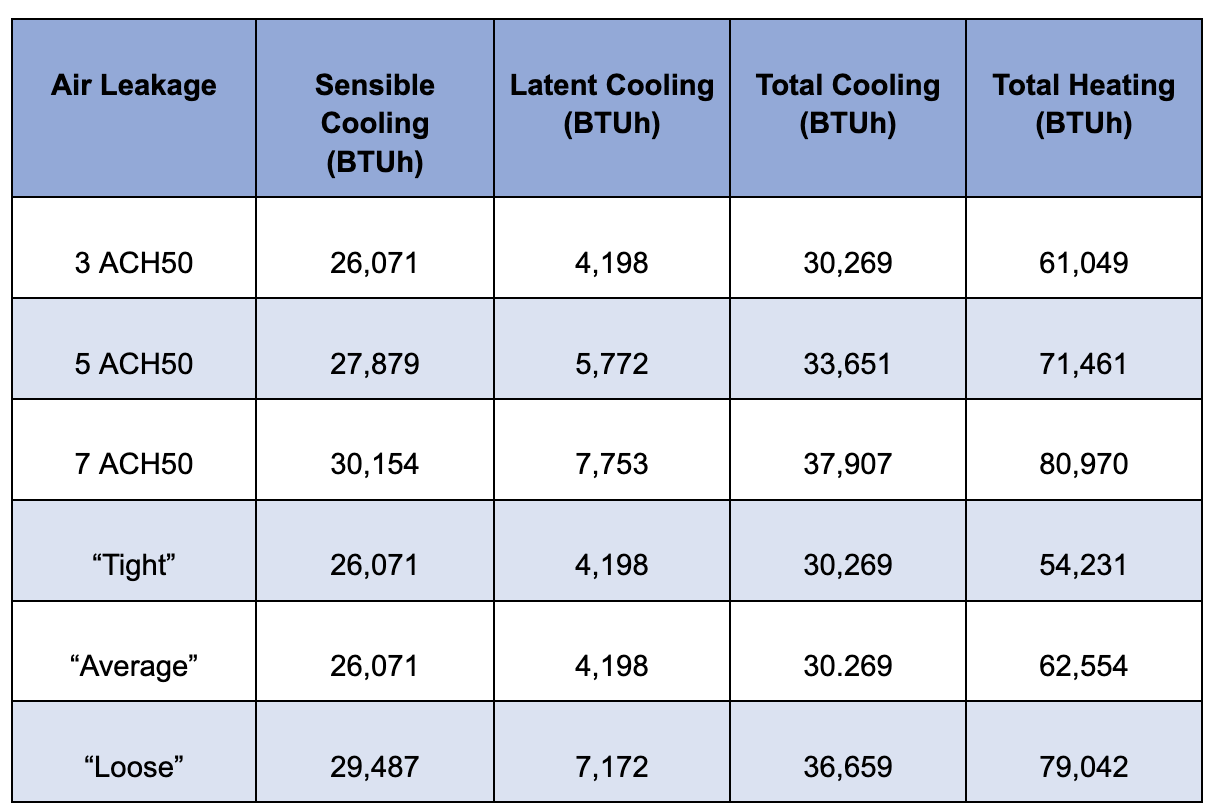Save on HVAC Costs with Improved Air Sealing and Insulation


“Build Tight, Ventilate Right” is an often used phrase in “high-performance building.” High-performance sounds like it is expensive. However, we need to evaluate trade-offs between upfront costs and long-term savings. This benefits both builders and homeowners, as smaller capacity equipment may be purchased at a lower initial cost, and more efficient homes will be more affordable to heat and cool year-round.
Codes have improved homes for the benefit of homeowners
For example, a 3,000-square-foot home built in the early 2000s required 4 tons or more of air conditioning. Today, that same-size home needs half as much when using high-performance standards. The trick for many builders is ensuring their building envelopes are modeled properly for their HVAC systems. This equipment, by law, must be sized according to ACCA Manual S and be based on loads calculated by ACCA Manual J. But what does this mean, and how can it be used to save builders money?
The Air Conditioning Contractors of America (ACCA) is a national non-profit association for the heating, ventilation, air conditioning, and refrigeration systems industry. It writes standards for how to design HVAC systems, and it is these standards that state building codes have adopted. The two used for homes, Manual J and S, document the requirements for calculating a building’s heating and cooling loads (Manual J) and identify the procedures used select equipment capacity (Manual S) that meet those loads. The result is a report that states building loads in BTU per hour (BTU stands for British Thermal Units) and corresponding total tonnage. For those new to the industry, 12,000 BTUh equals one ton.
While ACCA’s standards provide the “how,” Manual J and S alone do not guarantee that a home’s heating and cooling loads have been properly calculated or that appropriate equipment has been selected. If improper inputs are used, the results will likely recommend an oversized system. A common complaint of HVAC load calculations is that contractors rely on a rule of thumb for system sizing rather than refer to actual building components. This outdated process ties air conditioning to the size of the house, estimating that one ton of air conditioning is needed for every 400-600 square feet. Even after load calculations became required by the Georgia energy code, this rule of thumb has persisted, with many not trusting reports that say one ton can adequately condition 1,000 square feet or more of conditioned space.
Air Sealing makes a huge difference
The primary reason for this change is that building envelopes have improved dramatically. Wall and ceiling insulation levels have increased, and windows have become more efficient. Building air tightness has dropped from more than 7 Air Changes per Hour (ACH50) in the 2000s to 5 ACH50 today, even lower for builders who use high-performance building standards.
Many high-performance builders target less than 1 ACH50, 300-500% tighter than most local energy codes require. Earthcraft House requires 3 ACH50 or less, and Passive House minimum requirement is .6 ACH50.
Air leakage is an important input in HVAC load calculations since it impacts a home’s heating, sensible cooling, and latent cooling loads. By reducing uncontrolled outdoor air leakage, an airtight building envelope can retain its indoor conditioned air. This works with the building insulation in the winter to slow heat loss. This keeps hot, humid outdoor air from entering the building in the summer. When using ACCA Manual J, HVAC designers are required to account for air leakage. Unfortunately, defaults are commonly used in the software, allowing users to select entries that range from “loose” to “tight” that assign air tightness based on the building height and square footage. There is also a way to enter actual building blower door test results or ACH50 targets. However, most users rely on these defaults.
A model home was created based on the EarthCraft House standards to explore the difference between defaults for air leakage and air leakage test results. It is a two-story, 3,400-square-foot home located in Atlanta. The heating and cooling loads were modeled using an ACCA-approved software called Carmelsoft HVAC ResLoad-J, with different air leakage inputs used.

In this example, the cooling and heating loads are impacted differently by the air leakage entry used. The calculated loads are well below the old rule-of-thumb method in each case. Builders today, if they are not already, should talk with their HVAC contractors about the Manual J and S models for their own homes. The energy savings achieved by better building envelopes are meant to benefit them, too, not just their homebuyers.
Cost savings for builders and consumers
The most convincing way for builders on tight budgets to adopt “high-performance building” is to show obvious trade-offs in upfront costs and “callbacks.” Making a building more airtight and adding insulation using advanced framing or continuous insulation on the exterior will allow you to install a smaller HVAC system. This means that the cost of the equipment and ductwork will be less. In some cases, builders have claimed that there is a direct trade-off between the savings for HVAC equipment and the extra costs for air sealing and insulation.
The big winner is the occupant of the house. Lower operating costs in a market where energy prices will continue to rise are why most people prefer energy-efficient homes. Fewer drafts mean better comfort and health for the residents. Leaks in the exterior can allow pollution or nature, such as pollen, to enter the house. These allergens can be controlled by having a tight building envelope, a good filtration system on the HVAC system, and a filter on the fresh air intake.
- Filed Under: Energy
- Keywords : Green Building, Energy Efficiency, High Performance Building, HVAC, Building Codes, Weatherization, Energy Codes, air sealing, Heating, Cooling
- ( 7202 ) views

I own SawHorse, Inc, a green design + build firm in Atlanta, GA. We focus on high-performance buildings and create showcase houses to demonstrate cutting-edge building techniques.
- ( 4 ) Ratings
- ( 15 ) Discussions
- ( 7 ) Group Posts
Reply/Leave a Comment (You must be logged in to leave a comment)
Connect with us!
Subscribe to our monthly newsletter:
 Greenbuild Report Out, 2025 Nov 12, 2025
Greenbuild Report Out, 2025 Nov 12, 2025






























Not a Member Yet? Register and Join the Community | Log in